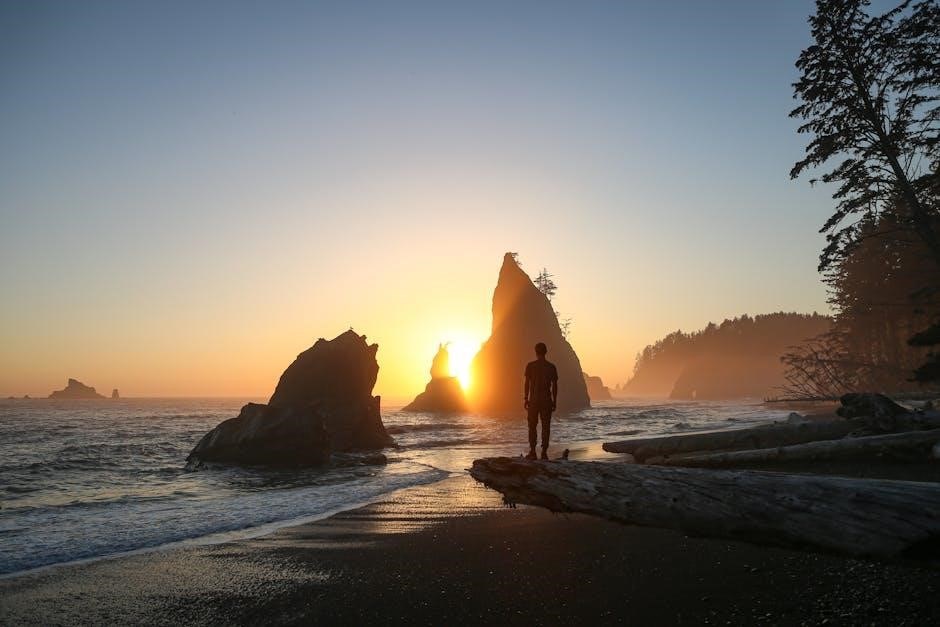Olympic National Park is a unique destination offering diverse ecosystems, including rainforests, mountains, and coastlines. Guided hikes provide expert insights, enhancing exploration and ensuring safety.
Olympic National Park Overview
Olympic National Park, located on the Olympic Peninsula in Washington, is a diverse and breathtaking destination. It features three distinct ecosystems: glacier-capped mountains, old-growth rainforests, and over 70 miles of coastline. The park is renowned for its natural beauty, with attractions like the Hoh River, Hurricane Ridge, and the Hall of Mosses. Visitors can enjoy a wide range of activities, including hiking, fishing, camping, and tidepooling. Guided hikes are particularly popular, offering unique insights into the park’s history, geology, and wildlife. For first-time visitors, planning is key, with resources like guidebooks and park apps providing essential information. The park’s diverse landscapes make it a must-visit for nature enthusiasts and adventurers alike.
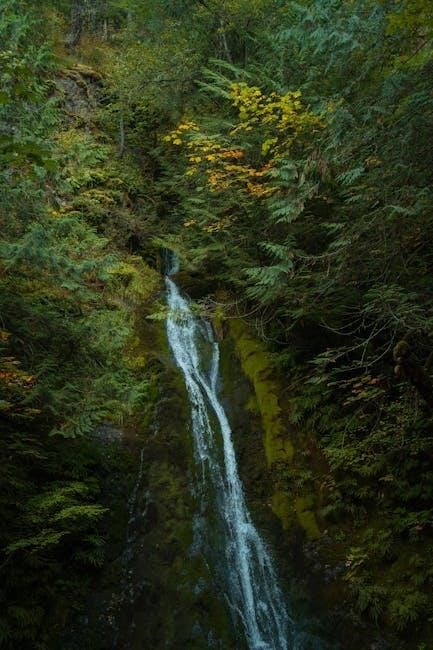
Unique Features of the Park
Olympic National Park stands out for its unparalleled diversity of ecosystems. The Hoh Rainforest, one of the largest temperate rainforests in the U.S., is a marvel with its moss-draped trees and lush vegetation. The park’s rugged coastline, dotted with tidepools and driftwood, offers a unique marine environment. Hurricane Ridge provides stunning mountain views, while the Quinault Rainforest adds to the park’s natural richness. These distinct landscapes, accessible through various trails, make Olympic National Park a haven for exploration. Guided hikes allow visitors to delve deeper into these features, uncovering hidden gems and learning about the park’s ecological and cultural significance.
Why Guided Hikes Are Beneficial
Guided hikes in Olympic National Park offer unparalleled benefits for visitors. Experienced guides provide in-depth knowledge about the park’s ecosystems, history, and wildlife, enriching the hiking experience. They ensure safety by navigating challenging trails and handling emergencies, making the adventure accessible to all skill levels. Guides also reveal hidden gems and lesser-known routes, maximizing exploration. Additionally, they offer insights into the park’s unique biodiversity, such as the Hoh Rainforest and coastal tidepools, enhancing understanding and appreciation. Whether you’re a novice or an expert, guided hikes guarantee a memorable and educational journey through Olympic National Park’s stunning landscapes.
Types of Hikes in Olympic National Park
Olympic National Park offers diverse hiking options, from rainforest trails like the Hoh River and Hall of Mosses to coastal tidepooling and mountainous Hurricane Ridge hikes.
The Hoh River Trail
The Hoh River Trail is a bucket-list-worthy hike in Olympic National Park, offering stunning views of the Hoh River and surrounding rainforest. The trail begins along the river, winding through lush vegetation and towering spruce and fir trees. It’s part of the Hoh Rainforest, one of the largest temperate rainforests in the U.S. The trail stretches 17.3 miles to the Blue Glacier, but hikers can enjoy shorter sections for a taste of its beauty. Guided hikes are highly recommended to explore this trail, as experts provide insights into the ecosystem and ensure safety. The trail’s serene atmosphere and diverse wildlife, such as elk and eagles, make it a memorable experience. The Hoh River itself, sourced from Mount Olympus, adds to the trail’s unique charm.
Hurricane Ridge Hikes
Hurricane Ridge offers a variety of hikes, from easy strolls to challenging treks, with breathtaking views of the Olympic Mountains and the Strait of Juan de Fuca. The Big Meadow Loop is a short, family-friendly option, while more adventurous hikers can explore trails like the Hurricane Hill Trail or the longer routes leading to alpine lakes and meadows. Guided hikes are particularly beneficial here, as experts can navigate the sometimes unpredictable weather and steep terrain. In summer, wildflowers blanket the meadows, and in winter, the area transforms into a hub for cross-country skiing and snowshoeing. The ridge’s high elevation provides panoramic vistas, making it a must-visit for any hiker.
The Hall of Mosses Trail
The Hall of Mosses Trail is a iconic hike in Olympic National Park, located within the Hoh Rainforest. This short, 0.8-mile loop trail is renowned for its lush, vibrant environment, where towering spruce and fir trees are draped in thick moss. The trail offers an immersive experience into one of the largest temperate rainforests in the U.S. Guided hikes here provide insights into the unique ecosystems and the role of mosses in the rainforest. The trail’s magical ambiance, with its emerald-green surroundings, makes it a favorite among visitors. It’s an ideal choice for those seeking a tranquil and educational hiking experience amidst nature’s splendor.
Tidepooling and Coastal Hikes
Olympic National Park’s coastline offers breathtaking opportunities for tidepooling and coastal hikes. The rugged shoreline, dotted with giant driftwood and tide pools, is home to diverse marine life, including starfish, anemones, and crabs. Guided hikes along the coast provide expert insights into the unique ecosystems and the best spots to explore. These hikes often include stops at iconic locations like Ruby Beach and Kalaloch, where dramatic sea stacks and tide pools captivate visitors. Guides share knowledge about marine biodiversity, tidal patterns, and the park’s coastal history, enhancing the experience. Whether walking along sandy beaches or navigating rocky shores, coastal hikes in Olympic National Park are unforgettable adventures.
Other Popular Hiking Trails
Beyond the iconic trails, Olympic National Park boasts a variety of other popular hiking paths that cater to different skill levels and interests. The Quinault Rainforest Trail offers a serene walk through lush vegetation, while the Kestner Homestead Trail provides a glimpse into the park’s historical past. For those seeking longer adventures, the Graves Creek Trail leads into the heart of the Hoh River valley, offering stunning views and opportunities for backcountry camping. Additionally, the Spruce Railroad Trail, located near Lake Crescent, features remnants of an old railroad and picturesque lake views. These trails, while less crowded than some, still offer the same natural beauty and diverse ecosystems that make Olympic National Park renowned. Guided hikes on these paths ensure visitors make the most of their experience.
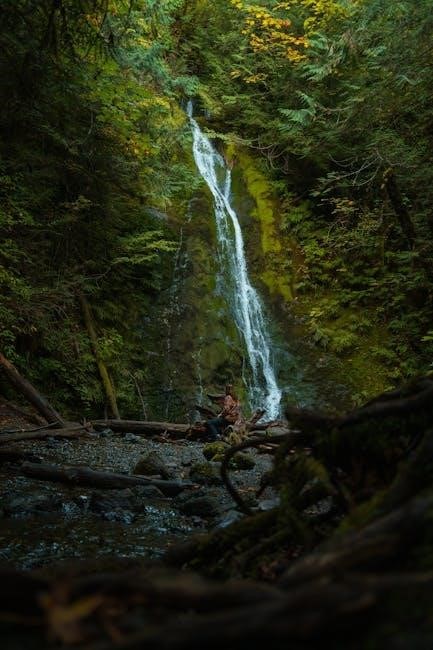
Best Times to Visit Olympic National Park
The best times to visit Olympic National Park are during summer for dry weather and accessible trails, or spring for wildflowers and fewer crowds.
Seasonal Variations in Weather
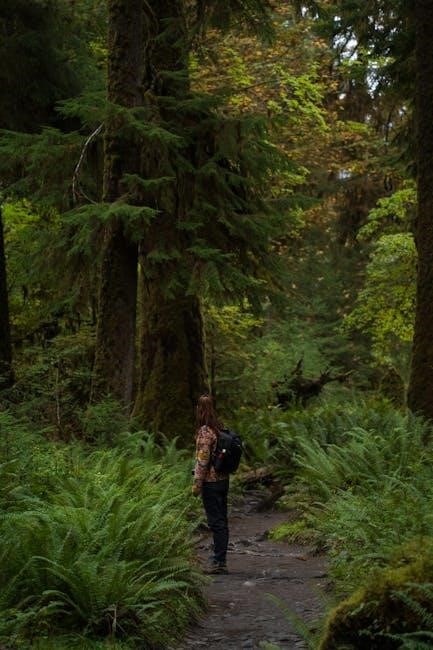
Olympic National Park experiences distinct seasonal weather patterns. Winters are wet and mild, with heavy rainfall, while summers are drier and warmer, ideal for hiking. Spring brings wildflowers and cooler temperatures, while fall offers crisp air with increased rain. The park’s diverse ecosystems mean weather can vary significantly by region, with rainforests remaining lush year-round and mountain areas receiving snow in winter. Understanding these seasonal variations helps visitors prepare for their hikes, ensuring they pack appropriate gear, such as waterproof clothing and sturdy footwear. Checking local forecasts before planning hikes is essential to make the most of your visit.
Best Seasons for Hiking
The best seasons for hiking in Olympic National Park are summer and early fall. Summer offers warm, dry weather, with wildflowers blooming in subalpine areas. Early fall provides cooler temperatures and fewer crowds. The park’s diverse ecosystems mean each season offers unique experiences: spring brings lush greenery and waterfalls, while late fall and winter are ideal for rainforest treks. Guided hikes can help visitors make the most of any season, providing insights into trail conditions and scenic highlights. Always check weather forecasts and trail conditions before heading out, especially in winter months when snow and rain can affect accessibility.
Wildlife Activity Throughout the Year
Olympic National Park is a haven for wildlife enthusiasts, with its diverse ecosystems supporting a wide range of species. Black bears, mountain goats, and Roosevelt elk are common sightings, while marine life like seals and whales can be spotted along the coast. Guided hikes often provide expert insights into tracking and identifying wildlife. Birdwatchers will delight in the park’s varied avifauna, including eagles and ospreys. Wildlife activity varies seasonally, with spring and fall offering peak viewing opportunities. Early mornings and late evenings are ideal for spotting animals in their natural habitats. Joining a guided hike can enhance your chances of encountering wildlife, making your visit even more memorable.
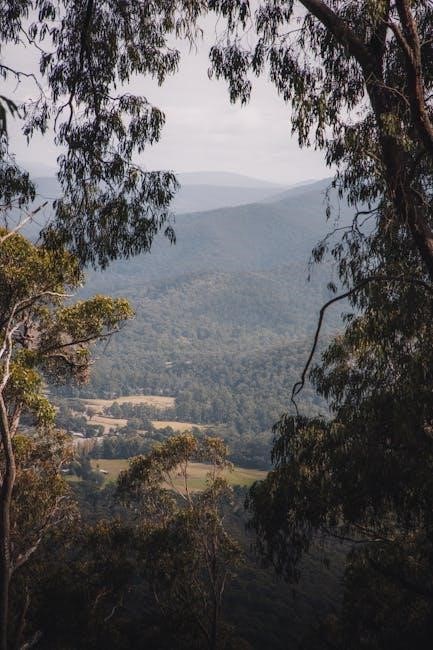
Essential Gear for Hiking
Sturdy footwear, waterproof layers, map, compass, headlamp, and water are must-haves. A first-aid kit and snacks ensure preparedness for Olympic National Park’s diverse trails and weather conditions.
Must-Have Clothing Items
When hiking in Olympic National Park, it’s essential to dress in layers to adapt to changing weather conditions. Start with a moisture-wicking base layer to keep dry. Add an insulating fleece or wool layer for cooler temperatures, especially in the mountains. A waterproof and breathable jacket, such as Gore-Tex, is crucial for rain and wind protection. Sturdy, water-resistant pants are recommended for rugged trails. Don’t forget a hat, gloves, and warm socks for colder sections like Hurricane Ridge. Quick-drying, breathable fabrics are ideal for the park’s diverse ecosystems, from rainforests to coastal beaches. Proper clothing ensures comfort and safety during your guided hikes.
Footwear Recommendations
Proper footwear is essential for hiking in Olympic National Park. Opt for sturdy, waterproof hiking boots or trail shoes with excellent traction to handle wet, muddy, and uneven terrain. Ankle support is crucial for navigating rugged trails like the Hoh River Trail or Hurricane Ridge. Choose breathable materials to keep feet dry and comfortable in the park’s damp climate. Consider waterproofing treatments for added protection against rain and puddles. Moisture-wicking socks are also recommended to prevent blisters and keep feet dry during long hikes. Durable footwear ensures safety and comfort, allowing you to fully enjoy the park’s diverse landscapes and guided hikes.
Navigation and Safety Tools
Essential navigation tools for hiking in Olympic National Park include a detailed map, compass, and GPS device or smartphone with a GPS app. Download the park’s map on the National Park Service app for offline use, as cell service is limited. Carry a first aid kit, whistle, and headlamp for emergencies. A portable charger ensures devices stay powered. Always inform someone of your itinerary before heading out. These tools enhance safety and preparedness, especially in remote areas with unpredictable weather. Proper navigation aids help prevent getting lost, while safety gear provides peace of mind during your guided or solo hikes through the park’s diverse trails.
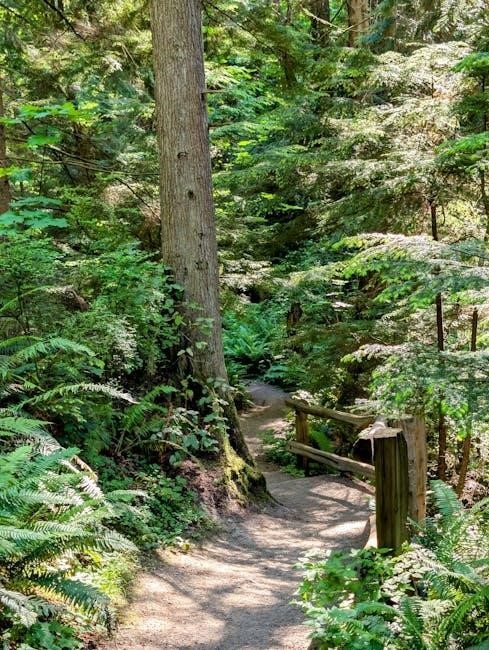
Safety Tips for Hiking
Always carry a map, GPS, and first aid kit. Inform someone of your itinerary and stay aware of changing weather conditions. Avoid hiking alone when possible.
Preparation and Planning
Before heading out, check the park’s website for trail conditions and download the Park Service app for offline access. Consult guidebooks or reputable sources for hike recommendations. Tailor your plans based on your fitness level and interests, whether it’s rainforests, mountains, or coastlines. Always carry essentials like a map, GPS, and first aid kit. Check weather forecasts, as conditions can change rapidly. Inform someone about your itinerary and expected return time. Wear sturdy footwear and appropriate clothing for the terrain and weather. Stay hydrated and bring snacks, especially for longer hikes. Respect wildlife by staying on designated trails and securing food properly.
Emergency Procedures
In case of an emergency, stay calm and assess the situation. Carry a first aid kit, a map, and a GPS device or compass. Ensure your phone is fully charged, though service may be limited. If lost, remain visible and avoid wandering. Use a whistle to signal for help. For wildlife encounters, maintain distance and avoid sudden movements. Injured hikers should stay put and send someone for help. Always inform a trusted person of your itinerary. Check the park’s website for up-to-date trail information and potential hazards. Familiarize yourself with basic first aid and know how to treat common injuries like sprains or cuts. Be prepared for changing weather conditions and carry extra supplies.
Wildlife Encounters
Olympic National Park is home to diverse wildlife, including black bears, mountain goats, and elk. When hiking, maintain a safe distance from animals to avoid startling them. Never feed wildlife, as this can disrupt their natural behavior. Be aware of your surroundings, especially in areas with low visibility, such as dense forests or coastal trails. Keep noise levels moderate to avoid surprising animals like deer or birds. If you encounter a bear, stay calm and follow proper protocols, such as giving it space and avoiding direct eye contact. Always carry bear spray and know how to use it. Staying on designated trails and hiking in groups can reduce the risk of wildlife encounters gone wrong. Guided hikes often provide additional safety measures and expert knowledge on wildlife behavior.
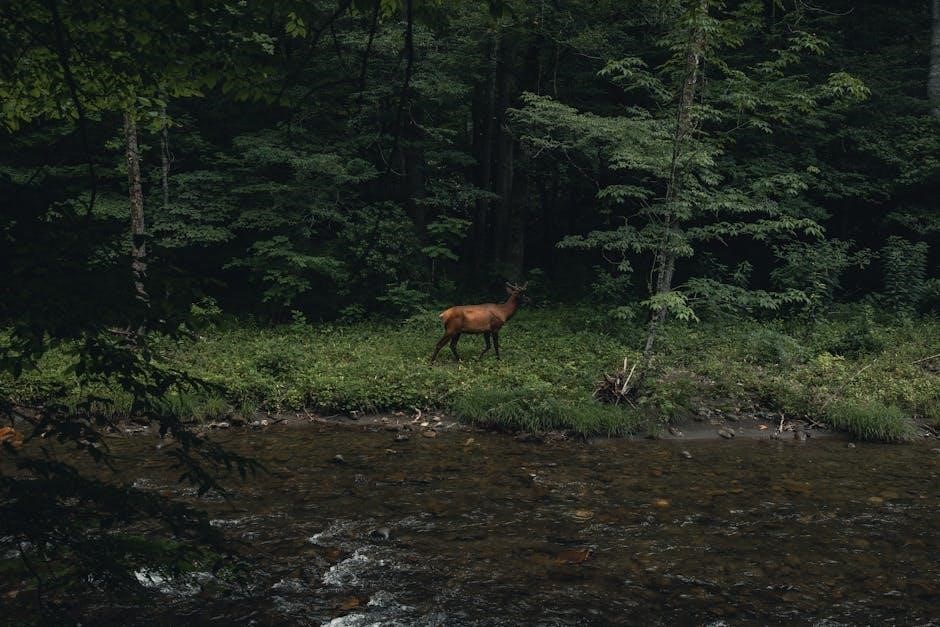
Guided Tours in Olympic National Park
Guided tours in Olympic National Park offer expert-led exploration of diverse ecosystems, ensuring safety and deep insights into the park’s natural and cultural wonders.
Choosing the Right Guide Service
When selecting a guide service for your Olympic National Park adventure, consider their reputation, experience, and expertise in the park’s unique ecosystems. Look for services with knowledgeable guides who can provide insights into the park’s geology, wildlife, and history. Check reviews and ask about their safety record and emergency preparedness. Ensure the service offers hikes tailored to your skill level and interests, whether you’re seeking rugged trails or family-friendly walks. Many services are certified by reputable organizations, ensuring high standards. Choosing the right guide enhances your safety and enriches your experience, allowing you to fully appreciate the park’s natural wonders and hidden gems.
Benefits of Guided Hikes
Guided hikes in Olympic National Park offer numerous advantages, enhancing your overall experience. Knowledgeable guides provide deep insights into the park’s ecosystems, history, and wildlife, enriching your exploration. They help navigate trails safely, ensuring you avoid hazards and make the most of your time. Guides also share hidden gems and less-traveled paths, offering unique perspectives. For first-time visitors, guided hikes alleviate the stress of planning and preparation. Additionally, guides are trained in emergency procedures, adding a layer of safety. This allows you to focus on enjoying the stunning landscapes, from rainforests to coastlines, while gaining a deeper appreciation for the park’s natural beauty and biodiversity.
Popular Guided Hike Options
Olympic National Park offers a variety of guided hikes catering to different interests and skill levels. The Hoh River Trail is a favorite, offering a serene journey through ancient rainforests. Hurricane Ridge hikes provide breathtaking mountain views and wildflower-filled meadows. For a shorter, magical experience, the Hall of Mosses Trail is ideal, with its stunning moss-covered trees. Coastal hikes, such as tidepooling excursions, allow visitors to explore marine life and dramatic shorelines. Guides also lead multi-day backpacking trips for adventurous explorers. These hikes ensure a memorable and immersive experience, leveraging the expertise of guides to uncover the park’s hidden gems and diverse ecosystems.
First-Time Visitor Tips
Plan ahead by checking the park’s website for trail updates and weather. Download the official Olympic National Park app for offline maps and guides. Choose hikes suitable for your fitness level, starting with shorter trails like the Hall of Mosses. Bring layers for unpredictable weather and wear sturdy footwear. Book guided tours in advance for a safer, more informative experience. Respect nature by staying on designated paths and carrying essential gear.
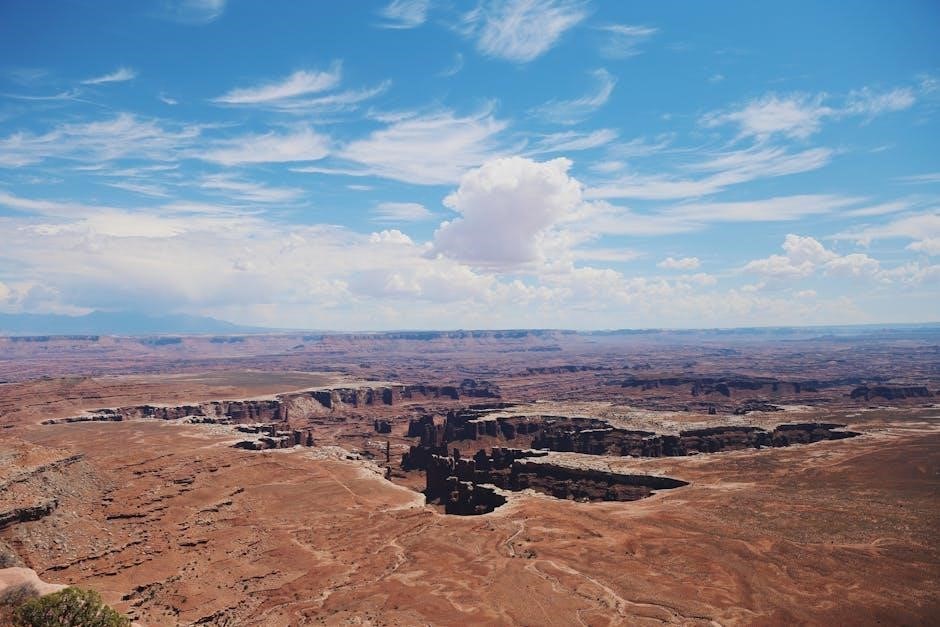
Planning Your Visit
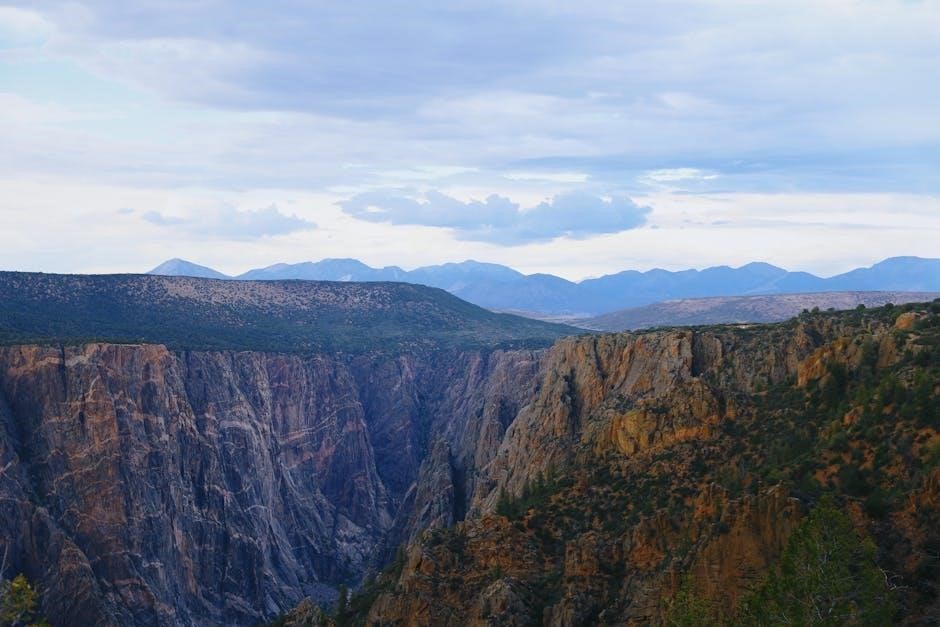
Planning your visit to Olympic National Park is essential for a seamless experience. Start by checking the park’s official website for up-to-date trail information and weather forecasts. Download the National Park Service app for offline maps and guides to navigate without cell service. Book accommodations and guided hikes in advance, especially during peak seasons. Consider the time of year and pack accordingly, as weather can be unpredictable. Choose hikes that match your fitness level, and don’t hesitate to seek advice from park rangers or local guides. Planning ahead ensures you make the most of your time exploring this stunning destination.
Must-See Attractions
Olympic National Park offers a wealth of breathtaking attractions that captivate visitors. The Hoh River Trail is a must-see, winding through ancient rainforests and offering stunning views of the Hoh River. Hurricane Ridge provides panoramic mountain vistas and vibrant wildflower meadows, perfect for photography. The Hall of Mosses Trail, located in the Hoh Rainforest, showcases towering moss-covered trees that feel like stepping into a fantasy world. Coastal areas like Ruby Beach and Kalaloch are ideal for exploring tide pools and dramatic driftwood scenery. These diverse ecosystems make Olympic National Park a unique destination, ensuring an unforgettable experience for first-time visitors and seasoned explorers alike.
First-Time Hiker Tips
For first-time visitors to Olympic National Park, planning is key to a successful hike. Start by choosing trails that match your fitness level, such as the short Hall of Mosses Trail or the Big Meadow Loop at Hurricane Ridge. Download the park’s app for offline access to maps and information. Pack essentials like water, snacks, and layered clothing, as weather can change quickly. Consider joining a guided hike to gain insights into the park’s history and ecosystems. Check trail conditions beforehand and inform someone of your itinerary. Respect wildlife and stay on designated paths to preserve the park’s natural beauty. With proper preparation, your first hike will be an enriching experience.
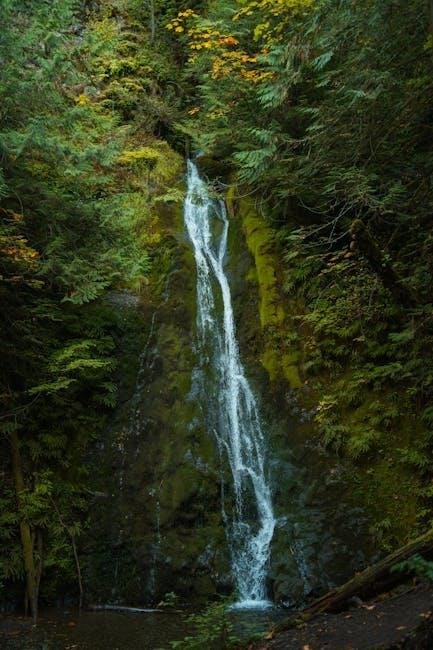
Wildlife and Ecosystems
Olympic National Park is home to diverse ecosystems, including rainforests, mountains, and coastlines, supporting a wide variety of wildlife such as black bears, Roosevelt elk, and marine species.
Diverse Ecosystems of the Park
Olympic National Park boasts an extraordinary variety of ecosystems, each offering unique landscapes and biodiversity. The Hoh and Quinault rainforests are among the largest temperate rainforests in the U.S., with ancient spruce and fir trees draped in moss. The park’s mountainous regions, such as Hurricane Ridge, feature alpine meadows and rugged peaks, providing habitat for wildlife like marmots and mountain goats. The coastline, with its dramatic tidepools and driftwood-strewn beaches, supports marine life and offers breathtaking ocean views. These diverse ecosystems make Olympic National Park a haven for hikers and nature enthusiasts, with guided hikes offering deeper insights into each environment’s unique characteristics and inhabitants.
Wildlife Viewing Opportunities
Olympic National Park is a haven for wildlife enthusiasts, offering diverse opportunities to observe animals in their natural habitats. The park is home to black bears, Roosevelt elk, and mountain goats, which can often be spotted during guided hikes. Coastal areas provide glimpses of seals, sea lions, and whales, while rivers teem with salmon and trout. Birdwatchers can enjoy spotting eagles, ospreys, and numerous songbird species. Guided tours enhance wildlife viewing by providing expert knowledge on tracking and identifying species. Whether exploring the rainforests, mountains, or coastlines, visitors are likely to encounter the park’s rich and varied wildlife, making each hike a memorable experience.
Accommodation and Dining
Olympic National Park offers cozy lodges and rustic cabins, blending comfort with nature. Dining options feature locally sourced cuisine, emphasizing fresh seafood and regional flavors, perfect for refueling after hikes.
Olympic National Park Lodging
Olympic National Park offers a variety of lodging options to suit different preferences and budgets. From cozy rustic cabins to comfortable lodges, visitors can immerse themselves in nature while staying within the park or nearby. The Sol Duc Hot Springs Resort and Lake Quinault Lodge are popular choices, providing stunning views and easy access to hiking trails. Kalaloch Lodge, perched on a bluff overlooking the Pacific Ocean, offers breathtaking coastal vistas. Many accommodations are strategically located near major attractions like the Hoh Rainforest and Hurricane Ridge, making it convenient for hikers to explore the park’s diverse landscapes. These lodgings ensure a memorable and comfortable stay amidst Olympic’s natural beauty.
Recommended Dining Options
Olympic National Park offers a variety of dining options that cater to different tastes and preferences. The Sol Duc Hot Springs Resort features a restaurant serving hearty meals, while the Lake Quinault Lodge offers fine dining with a focus on local ingredients. Kalaloch Lodge’s restaurant provides stunning ocean views alongside fresh seafood and regional cuisine. For casual eats, the Hoh Rainforest Café serves delicious burgers and sandwiches. Additionally, the Hurricane Ridge Café offers light bites and refreshments after a day of hiking. These dining spots not only provide nourishment but also allow visitors to connect with the park’s natural beauty and culture.
Comparing Olympic National Park to Other Parks
Olympic National Park stands out with its diverse ecosystems, offering unique hiking experiences compared to other parks like Mount Rainier, which is more alpine-focused.
Olympic vs. Mount Rainier National Park
Olympic National Park and Mount Rainier National Park offer distinct experiences for hikers. Olympic is known for its diverse ecosystems, including rainforests, mountains, and coastlines, while Mount Rainier focuses on alpine landscapes and glacier-capped peaks. Guided hikes in Olympic allow exploration of the Hoh Rainforest and tidepools, whereas Mount Rainier’s trails emphasize high-altitude adventures and wildflower meadows. Both parks provide unique wildlife viewing opportunities, but Olympic’s coastal access sets it apart. Visitors choosing Olympic often seek a broader range of environments, while those opting for Mount Rainier prefer challenging mountain hikes and iconic summit views. Each park caters to different hiking preferences and natural beauty.
Olympic National Park offers an unparalleled hiking experience with its diverse ecosystems and stunning landscapes; Guided hikes enhance exploration, providing expert knowledge and safety. From the Hoh Rainforest to coastal tidepools, each trail promises unique adventures. Whether you’re a novice or an experienced hiker, the park’s variety of trails ensures memorable experiences. Plan your visit wisely, prepare with essential gear, and consider guided tours for deeper insights. With its rich wildlife and natural beauty, Olympic National Park is a destination that leaves lasting impressions, making it a must-visit for outdoor enthusiasts seeking adventure and connection with nature.
